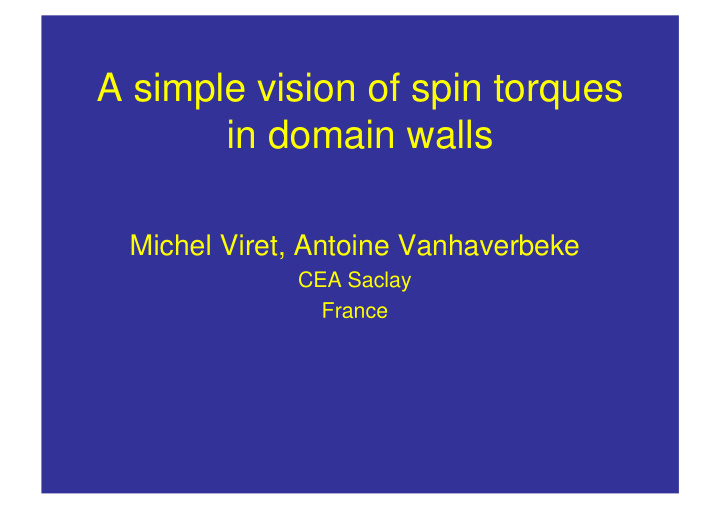



A simple vision of spin torques in domain walls Michel Viret, Antoine Vanhaverbeke CEA Saclay France
Micromagnetics of wall motion What happens to a transverse DW under application of a field or a current? Geometry : (A. Thiaville) 1 3 ∂ ∂ 2 4 r r = γ ⋅ × + α ⋅ × − ∇ + × ∇ m m r r r r r r r r LLG : H m m u m β ( ) ∂ ∂ u m m . t t (Velocity u=JgP µ B /2eMs) only H : → 1: � , 3: → , Demag � , 2: → , 3: � ⇒ steady state motion J only: 4: → , 1: → , 3: � , Demag � , 2: ← , 3: � ⇒ no steady state motion To obtain a steady state motion, one needs to introduce the beta term… But what is its microscopic origin?
Spin transfer from the conduction electrons to the DW Theory Current Two kinds of electrons: direction • Localised d electrons • Conduction electrons → s-d Hamiltonian Action of a current: Globally, the conduction electrons transfer g µ B to the DW
Spin evolution in the wall s-d Hamiltonian : : localised spins, s : conduction electrons Ballistic quantum calculation (Waintal+Viret, EuroPhys. Lett. 65, 427 (2004)) Φ ↑ ( x ) Spinor: Eigenstates: Ψ ( x )= R θ ( x ) Φ ( x ) Φ ↓ ( x ) Hamiltonian: Solution for linear walls: ( ) with P k =( k ↑ −k ↓ ) / ( k ↑ + k ↓ ) and ξ =e i ( k ↑ + k ↓ ) λ w Precession
Spin evolution in the wall: Simple (classical) calculation Precession equation : s-d Hamiltonian : ( ⇒ ) : localised spins s : conduction electrons In the rotating frame: ⇒
For a long wall and Precession around the effective field : Magnetisation Rotating frame Magnetic moment Laboratory frame Direction of electron propagation
The total moment is conserved → The torque can be decomposed into a constant and periodic part For long walls, the periodic part averages to zero and the constant part reads: This is in the wrong direction for pushing the wall (in steady state). But it distorts the DW. Equivalent to a transverse field →
Spin-flip terms included in Landau-Lifshitz → with → → Precession around a tilted effective field:
Reaction of the new component on the local magnetisation: = Li + Zhang term However : if the total magnetisation is preserved, then dM/dt = -d µ /dt and a second term appears: Which leads to the full cancellation of the ‘beta’ term! → Conceptual problem of spin flip events: do they conserve the total M or not? → Fundamental difference in scattering events: magnons/phonons ? P = polarisation, For non M conserving j = current density events , we get for the two constant torques : Conclusion: The beta term might depend on the nature of scattering processes. It is at most β β = τ τ ex / τ τ sf β β τ τ τ τ
‘Not so thick walls’: numerical simulations Torques within the wall : (red: distortion, black: pressure) Influenced by the shape and width of the DW… Bloch wall: smooth boundary conditions prevent the spin precession of conduction electrons
‘Not so thick walls’: numerical simulations Averaged torques on the wall width : Differences for linear and Bloch walls Distortion due to the suppression of spin precession in Bloch walls. ‘distortion’ Remark : constraint narrow DWs are likely to be linear walls ( N. Kazantseva, R. Wieser, and U. Nowak, PRL94, 037206 Pressure ‘pressure’ (2005) )
Real systems? Non magnetic impurity pinning a Bloch DW: Spatially varying torques are very large near the impurity → de-pinning ?
Hall effect induced perturbation of current lines The Hall effect polarity changes at the DW → Current lines are distorted A perpendicular magnetic field is induced → Pressure L.BERGER, J. PHYS. CHEM. SOLIDS 1974
Tilted DWs Other effect when the wall is tilted : the DW gets electrically charged Hall effect induced extra current lines Hall effect induced extra electric field lines Electric pressure: Weak for thin films in 3d elements, not so weak for semiconductors See M. Viret, A. Vanhaverbeke, F. Ott, J.-F. Jacquinot, Phys. Rev. B 72 (14), 140403 (2005).
Conclusions for the theoretical part Conclusion for the theoretical part • Relevance of classical model for for spin evolution in the DW • Torques: non-homogeneous within the walls + small ‘pressure’ term • Importance of the magnetic structure of the DW •Very thin DWs: Enhanced pressure oscillating with thickness •‘Hall charge Effect’: Important for magnetic semi-conductors Independent of current direction.
Experimental: Pt/Co/Pt Very large perpendicular interface anisotropy (Co/Pt) Very well defined DW structure: Bloch wall + very thin ( = 5 nm) Perpendicular magnetisation: 2D system Extraordinary Hall Effect (measurement of DW position) voltmeter scanning MFM Tool : MFM under magnetic field with transport measurements
Domain drawing "Domain drawing" : The tip magnetisation is reversed and its stray field can nucleate locally a minority domain. Then the tip is demagnetised to minimise stray fields.
Domain Wall de-pinning Tip induced de-pinning assisted by the current J J = 7 10 11 A/m 2 Tip induced de- pinning of the DW
De-pinning wins over spin pressure Current pulses Measurement of Hall voltage in the cross during current pulses (several 10 µ s) B = 0 B = -1.5 mT Time (s) Time (s) The DW moves in the direction of the field
Current effect on noise in EHE Two-level fluctuations : Two-level fluctuations Time (s) Histograms of (R( t )-R( t-1 )) : DW + current: No DW:
Conclusion DC Current effect on DW : Mainly depinning + a little bit of pushing Qualitative agreement with modelled torques
Recommend
More recommend